Virgin Trains
 |
|
|---|---|
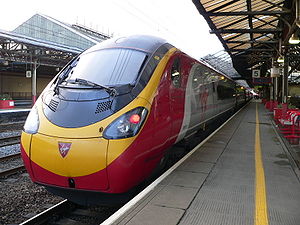 |
|
| Franchise(s): | InterCity West Coast 9 March 1997 – 31 March 2012 Cross-Country 5 January 1997 – 10 November 2007 (originally 2012) |
| Main route(s): | London - Scotland, London - West Midlands, London - North West |
| Other route(s): | London-North Wales, West Midlands — Scotland |
| Fleet size: | 52 Pendolino sets 21 Super Voyager sets 16 British Rail Class 57/3 diesel locomotives 10 British Rail Mark 3 coaches |
| Stations called at: | 42 |
| Stations operated: | 17 |
| National Rail abbreviation: | VT |
| Parent company: | Virgin Group / Stagecoach Group |
| Web site: | www.virgintrains.co.uk |
Virgin Trains is a train operating company in the United Kingdom which currently provides services from London Euston to the West Midlands, North West England, North Wales and Scotland, and from Birmingham New Street to North West England and Scotland, on the West Coast Main Line. Although it is branded as part of the Virgin Group, the group's share in the company is only 51%, with the remaining 49% held by Stagecoach Group.
Between 1997 and 2007 the company included Virgin CrossCountry, which provided services linking the south east and south-west of England with the north of England and Scotland via Birmingham. The majority of these services were transferred in 2007 to the new CrossCountry franchise, currently held by Arriva.
Virgin Trains was formed to take advantage of the privatisation of British Rail in the mid 1990s, and was initially successful in winning two franchises: InterCity West Coast and InterCity Cross Country.[1] The two franchises, although separate companies (in common ownership)[2] both legally and operationally, were marketed as a single brand.
Contents |
Current routes[3]
| Code | Route | Rolling stock | |
|---|---|---|---|
| A | London to the West Midlands | Pendolinos | |
| B | London to Manchester via Stoke-on-Trent or Crewe | Pendolinos | |
| C | London to Liverpool | Pendolinos | |
| D | London to Chester and North Wales | Super Voyagers | |
| E | London to the North West of England and Scotland | Pendolinos and Super Voyagers | |
| F | Birmingham to Glasgow and Edinburgh | Super Voyagers | |
Services
Virgin Trains runs nine trains per hour in and out of London's Euston station. This is busier than both East Coast (train operating company) in and out of Kings Cross (four trains per hour), and East Midlands Trains, (five per hour) in and out of St Pancras.
This timetable, marketed as "VHF" for "Very High Frequency", was introduced on 14 December 2008 as a result of the West Coast Main Line (WCML) route modernisation works. The general Monday — Friday service pattern is shown below. Other calls/timings occur, mainly at peak times. There are also "non- or limited-stop" trains running to justify the claimed fastest journey times (in advertisements for example). Most trains are run by Pendolinos with exceptions shown below:
Euston-West Midlands
| Route | Calling At | Main Stock | |
|---|---|---|---|
| XX:03 | London Euston-Birmingham New Street | Rugby, Coventry, Birmingham International | Pendolino |
| XX:23 | London Euston-Wolverhampton | Watford Junction, Coventry, Birmingham International, Birmingham New Street, Sandwell and Dudley | Pendolino |
| XX:43 | London Euston-Birmingham New Street /Wolverhampton | Milton Keynes, Coventry, Birmingham International (with some XX:43 services extended through Birmingham New Street to call at Sandwell and Dudley & Wolverhampton, and the 18:43 service extended through Wolverhampton to call at Stafford & Crewe) | Pendolino |
A handful of Birmingham terminators are operated by Super Voyagers (used for the few West Midlands-North Wales trains).
Euston-Manchester
| Route | Calling At | Main Stock | |
|---|---|---|---|
| XX:00 | London Euston-Manchester Piccadilly | Stoke-on-Trent, Macclesfield, Stockport | Pendolino |
| XX:20 | London Euston-Manchester Piccadilly | Milton Keynes, Stoke-on-Trent, Stockport | Pendolino |
| XX:40 | London Euston-Manchester Piccadilly | Crewe, Wilmslow, Stockport | Pendolino |
The three-trains-an-hour plan had a knock-on effect on local services in the Manchester area; a number of peak-period local trains were axed, which caused some controversy.[4]
Euston-Liverpool
| Route | Calling At | Main Stock | |
|---|---|---|---|
| XX:07 | London Euston-Liverpool Lime Street | Stafford, Runcorn, | Pendolino |
Average travel time for the whole journey was reduced from 2 hours 30 minutes to less than 2 hours 15 minutes.
Euston-Preston/Glasgow
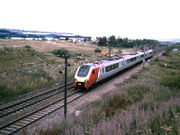
| Route | Calling At | Main Stock | |
|---|---|---|---|
| XX:30 | London Euston-Glasgow Central | Warrington Bank Quay, Wigan North Western, Preston and Lancaster with most continuing to Oxenholme Lake District/Penrith(alternating), Carlisle | Pendolino |
| 16:30 | London Euston-Glasgow Central | Preston | Pendolino |
| 18:46 Fridays Only | London Euston-Preston | Tamworth, Lichfield Trent Valley, Stafford, Crewe, Warrington Bank Quay, Wigan North Western | Mark 3 Class 90 |
A handful of Lancaster terminators are operated by Super Voyagers (half of a single unit split at Crewe, with the other half running towards Chester). Some also call at Motherwell
Birmingham-Edinburgh/Glasgow
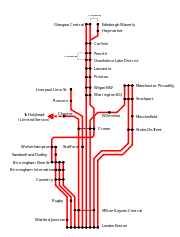
| Route | Calling At | Main Stock | |
|---|---|---|---|
| XX:20 | Birmingham New Street-Glasgow Central/Edinburgh Waverley | Wolverhampton, Crewe, Warrington Bank Quay, Wigan North Western, Preston and Lancaster with most continuing to Oxenholme Lake District/Penrith(alternating), Carlisle, Haymarket (Edinburgh only) | SuperVoyager |
Euston/West Midlands-Chester/North Wales
| Route | Calling At | Main Stock | |
|---|---|---|---|
| XX:10 | London Euston-Chester | Milton Keynes, Crewe | SuperVoyager |
| XX:10 (7 per day) | London Euston-Holyhead | Chester, Flint, Prestatyn, Rhyl, Colwyn Bay, Llandudno Junction, Bangor (2 terminating here) and Holyhead | SuperVoyager |
| 18:10 | London Euston-Wrexham General[5] | Milton Keynes, Nuneaton, Crewe, Chester | SuperVoyager |
| 08:50 Saturdays Only | London Euston-Holyhead | Watford Junction, Milton Keynes, Crewe, Rhyl, Colwyn Bay, Llandudno Junction, Bangor, | Pendolino |
One service goes to and from Birmingham New Street. This service is provided with Super Voyagers only (they are in double formation until Crewe or Chester and single formation after that, with one unit terminating at Chester or going to Lancaster, and the other continuing to North Wales/Chester).
At peak times, calls at Rugby, Milton Keynes and Watford Junction have been curtailed. London Midland provide commuter services for these stations instead, while Virgin trains make additional calls at Trent Valley stations: Lichfield Trent Valley (2),Tamworth (2) and Nuneaton (3). Sources for the new Virgin timetable:
Cross country
Until 11 November 2007, Virgin Trains ran the CrossCountry franchise, operating long-distance services from the south and south-west of England, via the Midlands to the north of England and Scotland. These services have now been transferred to a new franchise, CrossCountry, which was awarded to the Arriva Group, along with some former Central Trains services. However, the former Virgin Cross Country services between Manchester and Scotland were transferred to First TransPennine Express, and CrossCountry services between Birmingham and Glasgow have been transferred to Virgin West Coast.
Performance
Virgin Trains suffered poor punctuality compared with some other transport operators between 2001 and 2006 (based on official statistics from the Office of Rail Regulation). Punctuality has gradually improved and the latest figures published on Virgin Trains' website were 93% for the last 4 recorded weeks (25 July to 21 August 2010).[6]
The PPM MAA (Public Performance Measure Moving Annual Average - % of trains arriving within 10 minutes of the scheduled times) figures for Virgin Trains (Cross Country services and West Coast services) are as follows:
The financial year 2001-2 up to 31 March 2002: West Coast 68.7%, Cross Country 62.5% [7].
The financial year 2002-3 up to 31 March 2003: West Coast 73.5%, Cross Country 61.7% [8].
The financial year 2003-4 up to 31 March 2004: West Coast 74.8%, Cross Country 72.2% [9].
The financial year 2004-5 up to 31 March 2005: West Coast 72.1%, Cross Country 77.8% [10].
The financial year 2005-6 up to 31 March 2006: West Coast 83.5%, Cross Country 80.9% [11].
The financial year 2006-7 up to 31 March 2007: West Coast 86.0%, Cross Country 83.9% [12].
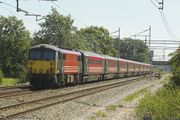
The financial year 2007-8 up to 31 March 2008: West Coast 86.2% [13].
The financial year 2008-9 up to 31 March 2009: West Coast 80.0% [14].
The final figures published for the CrossCountry franchise were 83.4% (PPM) for the first half of the third quarter of the financial year of 2007/8 and 85.3% (MAA) for the final 12 months of the franchise.[15]
The latest figures published for the West Coast franchise were 83.5% (PPM) for the fourth quarter of 2009/10 and 84.6% (MAA) up to 31 March 2010.[16] These figures are up 9.3% and 2.2% on the corresponding figures from the same period last year, and the 12 months up to 31 December 2009 respectively.
Problems with punctuality had been widely attributed by Virgin to the ageing and outdated infrastructure on which it ran.
History
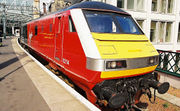
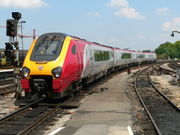
On privatisation, Virgin West Coast inherited a mixture of Mark 2 and Mark 3 coaches, with electric locomotives of Classes 86, 87 and 90. Virgin Cross-Country also inherited several Class 43 High Speed Trains, and Mark 2 coaches which were hauled by Class 47 diesel locomotives, and by Class 86 locomotives on electrified routes.
A drive led by Chris Green as chief executive[17][18] was made to improve reliability and punctuality after much press criticism in 2001, and by 2006, due to improved reliability of trains and completion of major infrastructure projects, performance was better. Virgin has undertaken a number of project to increase punctuality, including radio-controlled watches[19]
New trains, tracks and timetable
Virgin in 1997 placed the largest rolling-stock order (£1bn) in British history with new Class 390 Pendolino tilting trains for the West Coast Main Line (WCML) network. These state-of-the-art units are based partly on technology developed by British Rail for its prototype APT tilting train of the early 1980s; the technology was subsequently licensed to the Italian manufacturers. The Pendolino trains have a nominal top speed of 140 mph (230 km/h), but are limited by the existing signalling to 125 mph (200 km/h) on the WCML; there have been proposals for 135 mph (217 km/h) running on certain sections of the WCML, in particular the remodelled Trent Valley area, but these are yet to be considered by Network Rail. The cross-country routes were served by new diesel-electric four-coach Class 220 Voyager and five-coach Class 221 SuperVoyager trains. The SuperVoyager trains have tilting ability like the Pendolino, and were originally intended for services operating on routes not (or not wholly) electrified, such as Birmingham New Street to Reading, though some of them have more recently ended up on wholly electrified routes such as Birmingham to Glasgow due to a lack of electric stock.
By December 2004 Virgin Trains had replaced all the rolling stock inherited from British Rail. Although the new trains offer many features not available on the older stock, they also operate at higher densities, with some seats having reduced leg-room. The cramped conditions are attributable to the inward-leaning walls of the carriages that facilitate tilting. The trains were intended to work at much higher frequencies than under British Rail, and so each train has fewer seats than the ones it replaced. However, the extremities of the network did not get a higher frequency,[20] and key trains remain busy.[21]

The West Coast Main Line itself has been the subject of a £9bn refurbishment programme[22] to accept the new trains. This project ran three years over schedule, cost twice the original estimate, and was cut back so that the Pendolinos' 140 mph potential speed is not fully used, with trains running at a maximum 125 mph due to signalling constraints. (See West Coast Main Line for full details.)
In May 2003, Virgin Trains introduced some new set-down-only or pick-up-only stops into its passenger timetable. The aim of the restricted stops is to prevent short-distance passengers from overcrowding long-distance trains.
Additionally, some destinations, including Blackpool, Poole, Portsmouth, London Paddington and Swansea, were removed from the Virgin Trains network altogether, and some services pass through important junction stations, such as Didcot Parkway without stopping. As well as this, Milton Keynes Central is now sparsely served by peak-time West Coast services in order to deter commuters from using Virgin's services as an additional link to Euston.
By Spring 2009, WiFi internet connections (from T-Mobile) were available on all Pendolino and most Super Voyager trains. The service is free for first-class passengers, and a number of package options are open to standard-class passengers.
As of Spring 2010, Virgin Trains has disabled the on-board entertainment facilities on its services. Each seat originally had radio channels available through an in-seat control similar to In-Flight Entertainment.
Grayrigg derailment
On 23 February 2007, Pendolino 390033 forming the 17:15 service from London Euston to Glasgow Central derailed near Oxenholme in North West England.[23] The train was carrying about 180 people. Several carriages were left lying on the railway embankments. An 84-year-old woman, Margaret Masson from Glasgow, died in the crash. Five people were hospitalised with serious back, neck and head injuries. The accident was caused by a faulty set of points.[24] The train itself was widely praised for the way it stood up to the accident: it kept its shape while rolling down the embankment and did not lose its structural integrity.
The future
Projected growth in passenger numbers on the West Coast routes has prompted discussions about increasing the length of Pendolino sets to 11 vehicles.[25] The possibility of 10-car trains was foreseen in the original WCML strategy, so the infrastructure improvements required would be minimal. The DFT has ordered two extra coaches for 31 of the 52 sets to start with. These will be supplemented by four 11-car trainsets, ordered in 2008.[26] This is to be completed in time for the franchise change in March 2012.
Following completion of the Trent Valley Line quadrupling and Rugby junction upgrades to allow 125 mph running (completed by 2008), West Coast journey times fell further: Glasgow-Euston 4hr 15mins, Euston-Birmingham 1hr 10 mins (fastest) or 1hr 20mins (off-peak). Virgin claim that 135 mph running may be possible in places,[27] although Network Rail remain sceptical — stating that significant signalling upgrades would be required.
After much planning, an open-access operator, Wrexham & Shropshire submitted a plan to operate services between London Marylebone and North Wales. This involves traversing a short stretch of the WCML in the West Midlands area. Virgin Trains unsuccessfully objected to this proposal, which sees Wrexham & Shropshire having trains call at Wolverhampton. Due to the moderation of competition protection that is part of Virgin's West Coast franchise agreement, Wrexham & Shropshire had to submit a modified proposal that will involve only limited use of Wolverhampton, with Tame Bridge Parkway railway station used as its main Midlands stop. Wrexham & Shropshire began operations on 28 April 2008. In February 2008, Virgin announced that it would also begin services between London and Wrexham, but via Chester. Initially on a trial basis with one train per day on weekdays in each direction, should the service prove successful Virgin plans to introduce more services during the week and at weekends.[28]
Richard Branson has launched a campaign to have the next franchise period extended for 20 to 30 years, so that Virgin would be able to spend more on infrastructure and be able to see a return on investment.[29] He said the journey time between London and Birmingham could be reduced by 22 minutes to under one hour.
Also, Virgin and Stagecoach have expressed an interest in taking over the East Coast Main Line franchise in 2010 when the franchise is re-tendered.
Rolling stock
Current fleet
The majority of Virgin's services along the WCML are operated by its fleet of 52 nine-car Class 390 Pendolino EMUs. 16 Class 57 diesel locomotives were operated by Virgin, although four of these are now operated by Arriva Trains Wales, leaving Virgin Trains with 12. These locomotives are primarily used for "Thunderbird" duties. Virgin also operates 21 five-car Class 221 Super Voyager DMUs; these primarily operate on the WCML north of Birmingham, and on the North Wales line. In addition the 1846 standard-class-only Euston to Preston service on Fridays is operated by a Class 90 locomotive and DVT on hire from EWS, with a rake of MK3 coaches refurbished to Pendolino and Super Voyager standard.
Virgin Trains has now signed a lease on a rake of dedicated mark 3 coaches, with two DVTs. This set, nicknamed the 'Pretendolino', has been refurbished to the same standard as the Pendolinos and Super Voyagers. Re-upholstered seating, power points, wi-fi and a full external re-paint has been implemented. Virgin intends to use this set on the 1846 Euston to Preston service on Fridays and also to hire the train out as a charter train; it will also serve as a spare in the event of breakdown of a Pendolino or Super Voyager.[30][31]
| Class | Image | Type | Top speed | Number | Routes operated | Built | |
|---|---|---|---|---|---|---|---|
| mph | km/h | ||||||
| Class 57/3 |  |
Diesel locomotive | 95 | 153 | 12 | Thunderbird Locomotive | 2002–04 |
| Class 221 Super Voyager |  |
Diesel-Electric Multiple Unit | 125 | 200 | 21 | London - Chester/Holyhead Birmingham - Glasgow/Edinburgh |
2001–02 |
| Class 390 Pendolino | Electric Multiple Unit | 140 | 225 | 52 (1 beyond repair after Grayrigg Derailment) | London - Birmingham London - Manchester London - Liverpool London - Glasgow |
2001–04 | |
| Class 90 | Electric locomotive | 110 | 180 | 1 hired from DB Schenker |
18:46 Fridays Only London - Preston Charter Train Spare Train |
1987-90 | |
| Mark 3 Coach | Passenger Coach | 125 | 200 | 8 | 18:46 Fridays Only London - Preston Charter Train Spare Train |
1975 - 1986 (refurbished 2009) | |
| Driving Van Trailer | 125 | 200 | 1 | 18:46 Fridays Only London - Preston Charter Train Spare Train |
1988 (refurbished 2009) | ||
The Pendolino fleet is allocated to the Alstom Traincare Centre at Longsight (Manchester), with lighter maintenance and overnight stabling also carried out at Wembley (London), Oxley (Wolverhampton), Edge Hill (Liverpool) and Polmadie (Glasgow). Longsight is also 'home' to the Class 57 'Thunderbird' fleet. Thunderbird locomotives are stationed at strategic points along the WCML such as Crewe and Preston.
The Class 221 Super Voyager fleet is allocated to Bombardier's Central Rivers depot near Burton upon Trent.
See also
- Megatrain
- National Rail
References
- ↑ "Passenger Rail Franchises — Virgin Cross Country". Association of Train Operating Companies. http://www.atoc-comms.org/franchised-passenger-services-virgin-cross-country-trains.php.
- ↑ "Site Terms & Conditions". Virgin Trains. http://www.virgintrains.co.uk/termsandconditions/default.aspx.
- ↑ http://www.virgintrains.co.uk/assets/pdf/maps/network-map.pdf
- ↑ "Rush-hour trains may be scrapped". Knutsford Guardian. 10 March 2008. http://www.knutsfordguardian.co.uk/mostpopular.var.2095707.mostcommented.rushhour_trains_may_be_scrapped.php. Retrieved 2008-04-21.
- ↑ Virgin Trains (20 February 2008). "Wrexham set to join Virgin Trains network". Press release. http://www.virgintrainsmediaroom.com/index.cfm?articleid=1109. Retrieved 2008-02-21.
- ↑ "Virgin Trains' Performance". Virgin Trains. http://www.virgintrains.co.uk/assets/pdf/performance/vt-performance.pdf.
- ↑ "National Rail Trends 2001-2002 Quarter Four" (PDF). Strategic Rail Authority. http://www.rail-reg.gov.uk/upload/pdf/nrt0102-q4.pdf.
- ↑ "National Rail Trends 2002-2003 Quarter Four" (PDF). Strategic Rail Authority. http://www.rail-reg.gov.uk/upload/pdf/nrt0203-q4.pdf.
- ↑ "National Rail Trends 2003-2004 Quarter Four" (PDF). Strategic Rail Authority. http://www.rail-reg.gov.uk/upload/pdf/nrt0304-yr.pdf.
- ↑ "National Rail Trends 2004-2005 Quarter Four" (PDF). Strategic Rail Authority. http://www.rail-reg.gov.uk/upload/pdf/nrt0405-yr.pdf.
- ↑ "National Rail Trends 2005-2006 Quarter Four" (PDF). Office of Rail Regulation. http://www.rail-reg.gov.uk/upload/pdf/294.pdf.
- ↑ "National Rail Trends 2006-2007 Quarter Four" (PDF). Office of Rail Regulation. http://www.rail-reg.gov.uk/upload/pdf/330-rev4.pdf.
- ↑ "National Rail Trends 2007-2008 Quarter Four" (PDF). Office of Rail Regulation. http://www.rail-reg.gov.uk/upload/pdf/375.pdf.
- ↑ "National Rail Trends 2008-2009 Quarter Four" (PDF). Office of Rail Regulation. http://www.rail-reg.gov.uk/upload/pdf/YEARBOOK0809-v22.pdf.
- ↑ "National Rail Trends 2007-2008 Quarter Three" (PDF). Office of Rail Regulation. http://www.rail-reg.gov.uk/upload/pdf/356.pdf.
- ↑ "National Rail Trends Chapter 2". ORR. http://www.rail-reg.gov.uk/upload/pdf/NRTCh2Railperformance20100729.pdf.
- ↑ Thornton, Philip (17 February 1999). "The Player: Chris Green, Chief Executive of Virgin Rail: Right man to tackle 'mission impossible'". The Independent (London). http://www.independent.co.uk/news/business/the-player-chris-green-chief-executive-of-virgin-rail-right-man-to-tackle-mission-impossible-1071327.html. Retrieved 2009-06-06.
- ↑ Balmforth, John (2007). Virgin Trains: a decade of progress. London: Ian Allan. ISBN 978-0-7110-3224-8.
- ↑ Virgin Trains (28 February 2006). "Virgin Trains goes Atomic". Press release. http://www.virgintrainsmediaroom.com/index.cfm?articleid=831.
- ↑ VT/XC timetables
- ↑ In VT and XC timetables, these key trains were marked as such.
- ↑ "West Coast Main Line. Built in the 19th Century. Rebuilt for the 21st.". Network Rail. http://www.networkrail.co.uk/aspx/1328.aspx. Retrieved 4 July 2009.
- ↑ "Train crashes in Lake District". BBC News Online. 23 February 2007. http://news.bbc.co.uk/1/hi/england/6391633.stm. Retrieved 2007-02-23.
- ↑ "Rail crash report blames points". BBC News Online. 26 February 2007. http://news.bbc.co.uk/1/hi/uk/6398057.stm.
- ↑ "Pendolino lengthening and fleet expansion project". Department for Transport. http://webarchive.nationalarchives.gov.uk/+/http://www.dft.gov.uk/pgr/rail/pi/pendolinolengthening/.
- ↑ "West Coast Pendolino contract signed". Railway Gazette International (London). May 2008. http://www.railwaygazette.com/news_view/article/2008/05//west_coast_pendolino_contract_signed.html.
- ↑ Virgin Trains (24 April 2006). ""We've started.....so we'll finish," says Sir Richard". Press release. http://www.virgintrainsmediaroom.com/index.cfm?articleid=870. Retrieved 2008-08-06.
- ↑ "Wrexham to London rail link launch". Daily Post (Liverpool). 21 February 2008. http://www.dailypost.co.uk/news/north-wales-news/2008/02/21/wrexham-to-london-rail-link-launch-55578-20501954/.
- ↑ Wright, Robert (20 May 2009). "Branson urges £1bn rail spend". Financial Times (London). http://www.ft.com/cms/s/0/874d0afe-44cb-11de-82d6-00144feabdc0.html. Retrieved 2009-05-25.
- ↑ Google Groups page on the topic
- ↑ Fotopic.net pictures of the refurbished set
External links
- Virgin Trains web site
- Virgin Trains Pendolino Seat Plans from V-Flyer, customer created site.
- Virgin Trains Voyager Seat Plans from V-Flyer, customer created site.
- BBC News on Cross Country loss
| Preceded by InterCity As part of British Rail |
Operator of Cross-Country franchise 1997 — 2007 |
Succeeded by CrossCountry |
| Operator of InterCity West Coast franchise 1997 — 2012 |
Incumbent |
| Preceded by First Transpennine Express |
Train Operator of the Year 2007 |
Succeeded by Northern Rail |
|
|||||||||||||||||
|
|||||||||||||||||
|
|||||||||||||||||||||||
|
||||||||||||||||||||